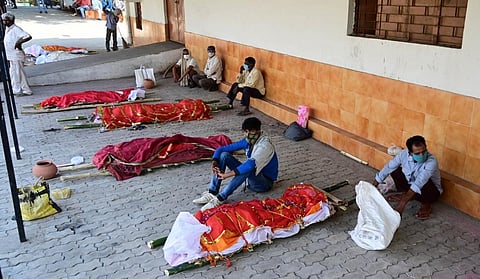It is time for us to leave the pandemic behind and concentrate on emerging pathogens: Chandrakant Lahariya
It is now more than three months since the World Health Organization (WHO) declared the COVID-19 pandemic to be over on May 05, 2023. Yet, the novel coronavirus or SARS-CoV-2 continues to return to mainstream news.
While most people across countries seem to have put COVID-19 behind, the presence of old posters and notices in public places asking us to maintain a two-metre distance or wear masks continue to remind of old times, though that was not very long ago.
However, it seems social media influencers (not necessarily domain experts), many of whom had grabbed eyeballs by writing about COVID-19 during the pandemic, keep searching for news on COVID-19 to remain relevant.
That’s why even a minor uptick in reported cases from any part of the world as well as changes in genomic sequence is used to start a discourse on social media. This, even as SARS-CoV-2 has become endemic now.
The most recent addition to the list is the emergence of a new SARS-CoV-2 subvariant EG.5, named ‘Eris’. This has been designated as a variant of interest by WHO.
However, EG.5 is similar to the XBB.1.5 subvariant and a sub-lineage of the Omicron variant — the last reported variant of concern (VoC) which is still in circulation. It is worth noting that even Omicron is not a VoC anymore.
It has been nearly 21 months since any new VoC of SARS-CoV-2 has been reported from any part of the world. This is the longest time since the first reporting of SARs-CoV-2.
Read Down To Earth’s three-year-long coverage of COVID-19 stories
But every emergence of a subvariant results in discussion about whether vaccines would work? Whether there would be a rise in cases and whether people should start wearing a mask?
Fortunately, most epidemiologists and trained public health specialists are confident and not much worried. But, vaccine manufacturers, EdTech owners and random hepatologists in faraway cities do start talking about the surge in cases. Each of them either have a vested interest or an ill-informed understanding of the virus. The fact remains that SARS-CoV-2 is not a threat anymore.
But then, what will be its likely trajectory in the times ahead?
The first thing to remember is that the novel coronavirus will not ‘go anywhere’. It is one of the seven known (and many unknown) coronaviruses. This family of viruses has been with humanity for long and they are not known to disappear.
Most coronaviruses cause mild symptoms although the situation with SARS-CoV-2 was completely unexpected. But now, the global population is exposed to it and the novelty of the virus is lost. Therefore, it is not an immediate concern.
Second, coronaviruses are known for mutations. In fact, all viruses are known for their mutations. Therefore, mere occurrence of a mutation carries no or very limited relevance.
What matters is if such mutations alter the character of the virus or drastically change the clinical outcomes. All of this is possible in the future, but the probability is very, very low. In fact, more people get sick due to other viruses such as those that cause influenza or dengue and we should be paying more attention to those.
Third, there is no need to wear masks or maintain distance for coronaviruses. Good respiratory etiquette needs to be followed to prevent any respiratory illness. However, there is no value in having to do so specifically and only for SARS-CoV-2.
Fourth, there is no need for a fourth shot of the COVID-19 vaccine in India, for any population group. It is difficult to predict whether we would ever again require a COVID-19 vaccine shot.
Maybe, in five years, the virus may change to a certain extent and immunity may decline. That is when some high risk people may require another shot. But, universal adult COVID-19 vaccines may not be needed, ever. Clearly, the COVID-19 vaccines are unlikely to be in the approach or style which we follow for annual flu vaccination.
Clearly, it is time to leave the pandemic behind. Yet, we need to focus upon post- and long Covid conditions. We need to focus upon increasing research on emerging viruses.
We need to focus upon preventing climate change and global warming, both of which are likely to increase the risk of emergence of new pathogens. It is time for countries to prepare for future epidemics and pandemics.
Scientists and epidemiologists are not in the business of prediction. Yet, I am trained to infer the likely trajectory of the emerging viruses.
Incidently, my first-ever public communication article in a mainstream newspaper was on SARS (now known as SARS-CoV-1) on April 17, 2003. In the last two decades, I have seen virus researchers respond to the Novel H1N1 2009 pandemic and support preparedness and responses to many other public health emergencies and emerging diseases such as Avian Flu (H5N1), Ebola, Crimean Congo Haemorrhagic Fever, CHF, Nipah and Zika viruses, in addition to being involved in the COVID-19 pandemic response in India.
I am aware that the subvariants of SARS-CoV-2 would keep emerging regularly. Scientists and virologists need to keep track of variants. There is a possibility of a localised surge in COVID-19 cases in the months and years ahead.
However, every new variant or subvariant is not of concern. Any future variant is unlikely to cause a major wave. The COVID-19 vaccines are unlikely to be recommended uniformly. The world should prepare for responding to emerging viruses.
SARS-CoV-2 is not a concern anymore. Not now, and very unlikely in the future.
Dr Chandrakant Lahariya is a practicing physician and leading epidemiologist and public health specialist, based out of New Delhi


